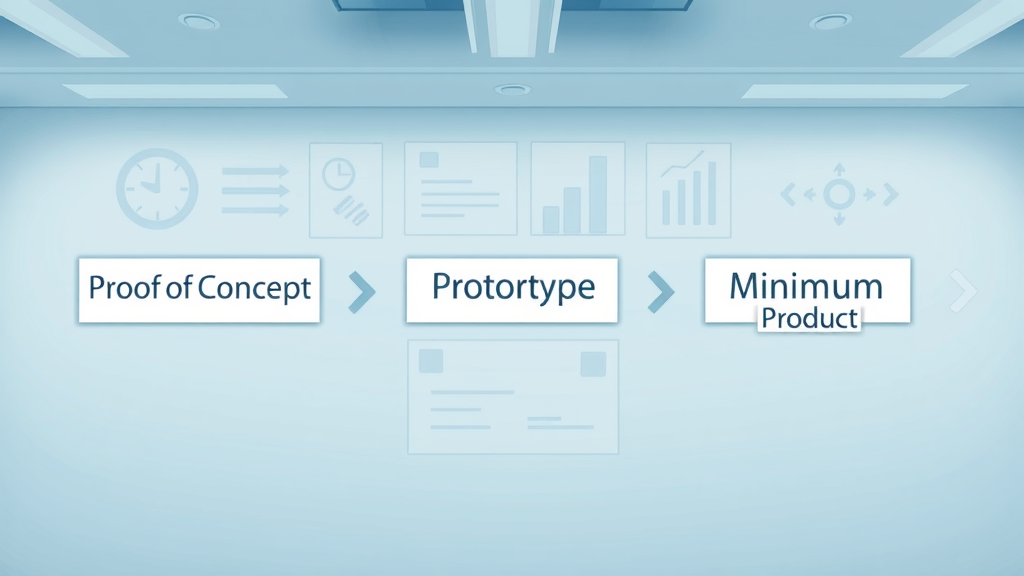Prototype Versus Proof of Concept: Demystifying the Distinctions for Modern Innovators
Did you know that over 70% of failed products skipped key validation steps like building a prototype or running a proof of concept? In the rapidly evolving world of software development and mobile app innovation, understanding the critical differences between prototype versus proof of concept is essential to launching a successful and viable product. Whether you’re refining your next big business concept or transforming a design concept into a functional product, this guide will clarify myths, answer FAQs, and show how industry leaders save time, reduce risk, and consistently meet market demand. Read on—your next breakthrough idea depends on it.
What You’ll Learn
- The fundamental differences between prototype and proof of concept
- How each applies to mobile app and software development
- When to use each to save time and money
- Practical real-world examples and mistakes to avoid
- How the minimum viable product fits into the journey

Why Prototype Versus Proof of Concept Matters: Surprising Insights Shaping Product Success
- Discover why over 70% of failed products skipped key validation steps around prototype versus proof of concept.
- Uncover how both play critical—but distinct—roles in mobile app development, software development, and building a minimum viable product.
- See how leading innovators leverage each to reduce costs, risk, and time to market.
The debate of prototype versus proof of concept isn’t just for tech giants—it’s a core issue for everyone in modern product development. When nearly three-quarters of failed products bypassed these validation steps, it’s clear that recognizing their differences is vital. For example, a proof of concept determines if something is technically possible, while a prototype shows user experience and validates your design concept. Overlooking either increases the chance of misreading market fit or spending resources on the wrong core feature. Savvy teams who save time and costs always ensure both steps are tailored to their product idea and target audience.
Innovators in software development and app development constantly face choices—pursue that big idea or validate technical unknowns first? By distinguishing between a PoC and a prototype, teams dramatically reduce risks, ensuring that when it’s time to build an MVP, it’s based on user insights and proven technology. Understanding this distinction enables quicker pivots, better user testing, and ultimately a smoother path from business concept to functional product.
Defining Prototype Versus Proof of Concept: Core Concepts Explained
What Is a Proof of Concept?

- Defining proof of concept in software development and product innovation.
- Real-world examples for mobile apps and digital products.
- When and why teams choose proof of concept first.
A proof of concept (PoC) is your project’s first line of defense against costly failure, focusing on validating whether a specific idea, feature, or technology is feasible in a real-world environment. In software development and mobile app projects, a PoC might be a simple working model or demo showing that complex integrations or algorithms can function as intended. This early stage is not about pixel-perfect visuals or user experience; it’s about answering the question: “Can we make this work?” For example, when building a new core feature in a mobile app, a PoC might demonstrate the backend logic necessary to support it.
Teams often run a proof of concept when the technical feasibility of a product idea is unknown—before investing heavily in product design or a final product. This process saves time and resources by exposing risks and flaws early, giving teams clear direction on technology choices and development process. Real-world examples include testing a new AI integration in a SaaS application or validating if a unique sensor works in a connected health device. By focusing on technical “can we do it?” instead of “should we build it?,” proof of concept prevents costly missteps.
“A proof of concept is the first line of defense against costly failure. It’s where ideas meet technical reality.” — Product Innovation Specialist
What Is a Prototype and How Does It Differ?

- Understanding prototypes in software development, product engineering, and mobile app design.
- Differences between prototype and concept design—beyond the obvious.
- Visualizing early-stage user journeys with clickable prototypes.
In contrast, a prototype is an interactive or visual model designed to mimic how a digital product will look and behave. It’s not just about the technical “can it work”—but rather, “how will users experience this?” Prototypes bring your design concept to life by allowing stakeholders to test flows, user interaction patterns, and user experience before the costly development process begins. In app development, it’s where the difference between a great idea and an engaging, functional product is most clear.
A prototype is often built after the feasibility is proven by a proof of concept, focusing on visual and experiential validation. For example, a clickable prototype enables user testing sessions where real feedback shapes refinements in layout, pain points, and core features, speeding up iterations and improving overall user satisfaction. This is especially useful in agile and design thinking workflows, where early-stage client review and feedback are keys to aligning the product with market fit.
Head-to-Head: Prototype Versus Proof of Concept in Product Development
| Aspect | Proof of Concept | Prototype |
|---|---|---|
| Objective | Validate feasibility | Test usability/experience |
| User Involvement | Internal teams | End users/stakeholders |
| Fidelity | Low | Medium to high |
| Use Case | Technical solutions | Design/user workflows |
| Examples (e.g., mobile app development) | Feature/functionality check | Clickable UI, mock-ups |
Placing prototype versus proof of concept side by side reveals how each addresses distinct needs at different stages of product development. A PoC is all about proving your core feature or business concept can technically work under real constraints. It’s inward-looking, focused mainly on engineering teams and early stages, addressing whether you can bring the vision to life. In contrast, a prototype is built for feedback from end users and stakeholders, optimizing for look, feel, and user experience. It bridges the gap toward the minimum viable product by refining user journeys and envisioning how your app or software will perform in the hands of real people.
This clear separation ensures technical problems are solved before investing in complex UI/UX or time-consuming design. By understanding this table, teams save time, avoid wasted resources, and ensure smoother transitions across the product development lifecycle.
Proof of Concept and Prototype in the Context of Mobile App and Software Development
When to Use a Proof of Concept in Your Software Project
- Technical unknowns: When the technology or integration is untested.
- Early-stage projects considering market fit.
- Reducing risk before building an MVP or viable product.
In software development and mobile app projects, using a proof of concept is particularly valuable when core technology choices or integrations have not been demonstrated in your context. Before committing to development resources, teams need to be sure their idea is technically feasible and aligns with market demand. For example, if your app requires integrating a brand-new payment gateway or using an unproven AI algorithm, running a PoC is the most logical first step. By validating your business concept in the early stages, you minimize risk and avoid investing in a minimum viable product built on shaky ground.
A PoC is also essential when your solution depends on solving a technical barrier not previously addressed in your organization. This iterative process helps identify potential challenges, guiding the approach for both design and development. By working through these hurdles early, your team can allocate time and resources effectively, ensuring smoother progress toward a fully functional product.
When to Build a Prototype for Effective Stakeholder Buy-In

- Showcasing the look and feel of a digital product.
- Gathering early user feedback to inform the minimum viable product.
- Prototyping in agile and design thinking workflows.
Prototyping is invaluable when you need feedback from end users, business stakeholders, or investors. If your product idea is validated as feasible through a PoC, the next logical step is to create a prototype that brings the concept to life visually and interactively. In app development, prototypes provide a version of the product that allows real user interaction, highlighting usability issues and valuable insights for improving user experience.
Prototypes also serve as effective communication tools. Investors and decision-makers can experience your product’s potential rather than imagine it from wireframes or static mock-ups. This collaborative spirit is a hallmark of agile development, enabling quick iterations based on user or stakeholder feedback, and ensuring that the final product delights your target audience.
“Prototypes transform abstract concepts into tangible experiences, driving user-centered development.” — UX Strategy Lead
Practical Examples: Choosing Between Prototype Versus Proof of Concept
Mobile App Case Study: From Proof of Concept to Viable Product

- Scenario: Validating a unique mobile app feature technically with a proof of concept.
- Transitioning to interactive prototyping for user feedback.
- Building a minimum viable product to launch in the market.
Imagine a startup with an innovative mobile app feature—such as real-time language translation during live video calls. The team first tests the technology with a proof of concept, demonstrating it’s possible to connect and process conversations in different languages. After confirming feasibility, their next step is to create a prototype: an interactive app interface that lets users simulate calls, test flows, and highlight pain points in the app’s user experience. With valuable feedback from these sessions, they move on to build an MVP (minimum viable product), offering a polished but streamlined product for early adopters—bridging the gap between big ideas and real market fit.
This phased approach—proof of concept to prototype to minimum viable product—maximizes learning at each stage, aligning technology, usability, and business goals. It’s a proven way to ensure innovation and user needs go hand in hand, from concept and prototype to a successfully launched app.
Software Development Scenario: Prototyping for Usability
- Iterating on UI/UX designs pre-development.
- Incorporating stakeholder input before finalizing the viable product.
- Comparing user engagement data from prototypes and minimum viable product releases.

Consider a software development team building a new dashboard for an analytics tool. Once the technical feasibility of capturing real-time data is proven with a PoC, the design team creates multiple prototypes to experiment with interface elements, navigation paths, and dashboard layouts. Stakeholders—ranging from end users to C-level executives—can interact with these versions, providing feedback before a single line of production code is written. The best-performing elements, based on user engagement and satisfaction, are further iterated before the team commits to an MVP or final product.
The iterative process is essential: user data from prototypes often differs from assumptions made during the concept phase, revealing insights that shape a more effective and user-centered viable product. This not only avoids costly rework but gives everyone—from developers to business owners—confidence in the development process.
Key Considerations: Selecting the Right Approach for Your Project
- Project risk profile: Unknown technology vs. undefined user need
- Timeline, budget, and resources
- Intended outcomes for mobile app, software development, and viable product roadmaps
- Involvement of stakeholders: Internal validation versus external user testing
Choosing between prototype versus proof of concept comes down to matching your current challenges with the right tool. If you’re staring down untested technology or a business concept that’s never been done, start with a PoC to assess technical feasibility—saving time and resources early in product development. If you already know the tech works but need to map user experience or secure stakeholder buy-in, move forward with a prototype. Consider timelines and budget: a well-scoped PoC is typically quicker and less expensive, while prototypes may require more design effort but reduce the risk of launching an untested final product.
Ultimately, clear project goals and a commitment to validating both technology and usability will lead you to the best sequence for your innovation journey.
How Minimum Viable Product Relates to Prototype Versus Proof of Concept
Minimum Viable Product: Bridging the Gap from Concept to Market

- Definition and role in the development process
- Comparison with proof of concept and prototype in scaling new ideas
- Example: Building an MVP for a new SaaS platform
- When to move from prototype or proof of concept to a minimum viable product
A minimum viable product (MVP) connects the dots between concept design, prototyping, and market-ready software. It is a stripped-down, functional product containing only the core features necessary to satisfy early adopters and gather user feedback. Unlike a PoC, which only proves technical feasibility, or a prototype, which tests flows and design, the MVP is intended for real-world use, delivering value to actual users. For instance, a SaaS startup may evolve from a PoC confirming cloud backend viability, through a clickable prototype for interface design, and finally to an MVP with critical features for its first customers.
Deciding when to build an MVP depends on validating assumptions. If the PoC and prototype have answered fundamental questions about feasibility and usability, the MVP becomes a logical next step toward market fit and scale.
“A minimum viable product is not a prototype or a proof of concept—it’s a functional launch pad built on validated assumptions.” — Tech Product Founder
Common Mistakes: Blurring Prototype Versus Proof of Concept in Product Teams
- Failing to validate core assumptions with a PoC before design
- Skipping prototyping and missing vital user feedback
- Investing heavily in minimum viable products without market validation
- Not aligning proof of concept outcomes with business goals
Product teams too often skip foundational steps—assuming technology will work without proof, or launching products without ever testing how users will interact. These errors commonly result when teams conflate a concept and prototype or rush from rough idea to MVP. Failing to validate technical feasibility with a PoC may doom projects before they start, while skipping the prototype stage often leads to painful rework or missed user needs. Avoiding these missteps preserves resources and increases the odds of a market success.
People Also Ask: Answers to Essential Questions
What is the difference between prototype and concept?
- A prototype is a tangible, testable version of a product concept, often used to gather feedback and improve user experience. A concept refers to the initial idea or vision, while a prototype moves the concept closer to real-world validation.
Is the prototype the same as PoC?
- No, a prototype is not the same as a proof of concept. A PoC checks if an idea or technology is feasible, while a prototype demonstrates how a user might interact with the solution.
What comes first, PoC or prototype?
- Typically, a proof of concept comes before a prototype. Validating feasibility with a PoC ensures it makes sense to invest effort in designing and prototyping user experiences.

What is the difference between concept design and prototype?
- Concept design lays the foundation of a product’s look, function, and purpose. Prototypes bring that design to life as interactive models for hands-on testing and refinement.
Frequently Asked Questions About Prototype Versus Proof of Concept
Can you use both a proof of concept and prototype in one project?
- Yes. Many successful projects start with a PoC, advance to a prototype for user feedback, and finish with a minimum viable product.
How do you know whether to invest in a prototype or proof of concept?
- Evaluate if you’re facing technical risk (start PoC) or need to validate user experience and interface (start prototype).
Are these steps essential before building a minimum viable product?
- While some startups jump directly to MVP, using both increases your chance of market fit and minimizes costly development errors.
Must-Have Best Practices for Managing Prototype Versus Proof of Concept

- Involve stakeholders early—especially in software development and mobile app product teams.
- Document and iterate on learnings from each phase.
- Use real-world user feedback to inform the minimum viable product.
- Match the approach to your project’s stage, goals, and resource constraints.
Strong product development teams know that rigorous documentation, frequent iteration, and engaging the right stakeholders at every phase create the fastest path to a successful launch. Balancing technical validation and user testing at the right time is key for any digital product.
“Early visualization can clarify team alignment and accelerate product-market fit. Videos bring this learning to life.” — Product Design Trainer
Watch: End-to-End Process of Proof of Concept, Prototype, and Minimum Viable Product Deployment
Real-World Results: Companies Winning with the Right Approach

- Startup A’s journey from PoC to MVP in mobile app development
- SaaS firm leverages prototypes for faster design cycles
- Enterprise: Proof of concept saves six figures in software development
Companies embracing the distinctions between prototype versus proof of concept repeatedly report shortened timelines, reduced spending, and greater customer satisfaction. Whether it’s a startup rapidly launching a new mobile app, a SaaS team cutting design time with clickable prototypes, or an enterprise saving hundreds of thousands by validating tech with PoC before scaling, the advantages are clear.
Summing Up the Prototype Versus Proof of Concept Journey
- Both prototype and proof of concept are essential tools for product success.
- Using the right tool at the right time reduces risk and accelerates innovation.
- Understanding each step—proof of concept, prototype, minimum viable product, and viable product—maximizes success in software and mobile app projects.
Accelerate Your Innovation: Take the Next Step
Need Help With Prototype or Proof of Concept? | Call Coach Shawn at Predaxis Leadership Solutions | (404) 491-1997
Actionable Step: Map where your current product or software idea stands: Do you need to start with technical feasibility or is it time to prototype user experiences? Use this clarity to save time and move confidently toward a market-ready, minimum viable product.
Sources
- Atlassian – https://www.atlassian.com/agile/project-management/proof-of-concept
- ProductPlan – https://www.productplan.com/glossary/prototype/
- SVPG – https://www.svpg.com/the-prototype-as-proof-of-concept/
- Airfocus – https://airfocus.com/glossary/what-is-minimum-viable-product-mvp/
Understanding the distinctions between a proof of concept (PoC) and a prototype is crucial in product development. A PoC is an early exercise aimed at validating the feasibility of a concept or idea, focusing on whether it can be realized technically. It often involves minimal development and serves to demonstrate that a particular method or idea has practical potential. (en.wikipedia.org)
In contrast, a prototype is an early model of a product that showcases its design, functionality, and user interactions. Prototypes are used to visualize how the product will function, allowing teams to gather feedback and make necessary adjustments before full-scale development. (en.wikipedia.org)
In summary, while a PoC answers the question, “Can this be done?” a prototype addresses, “How will this work?” Both are essential steps in the development process, each serving distinct purposes to ensure the success of the final product.
 Add Row
Add Row  Add
Add 


Write A Comment